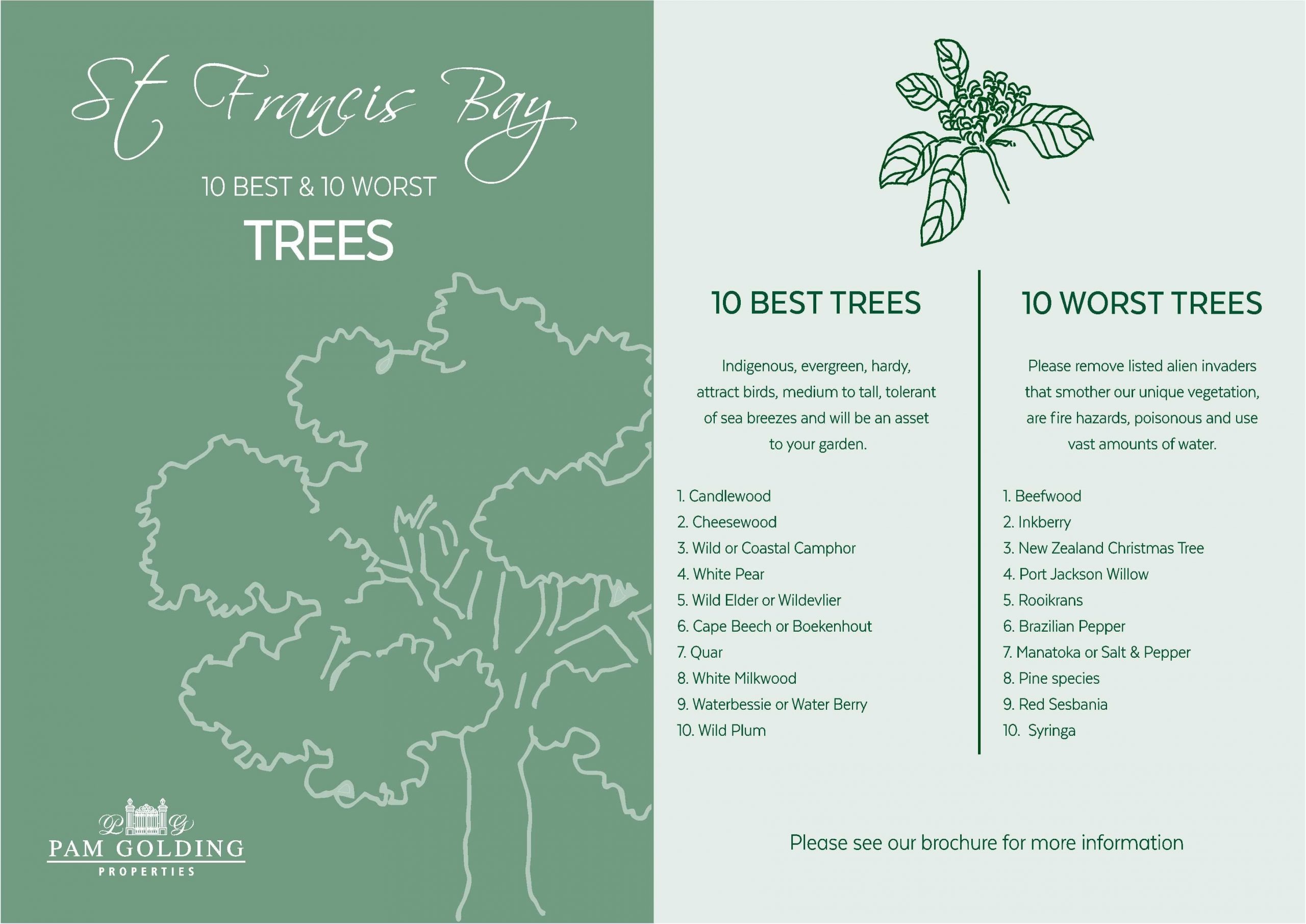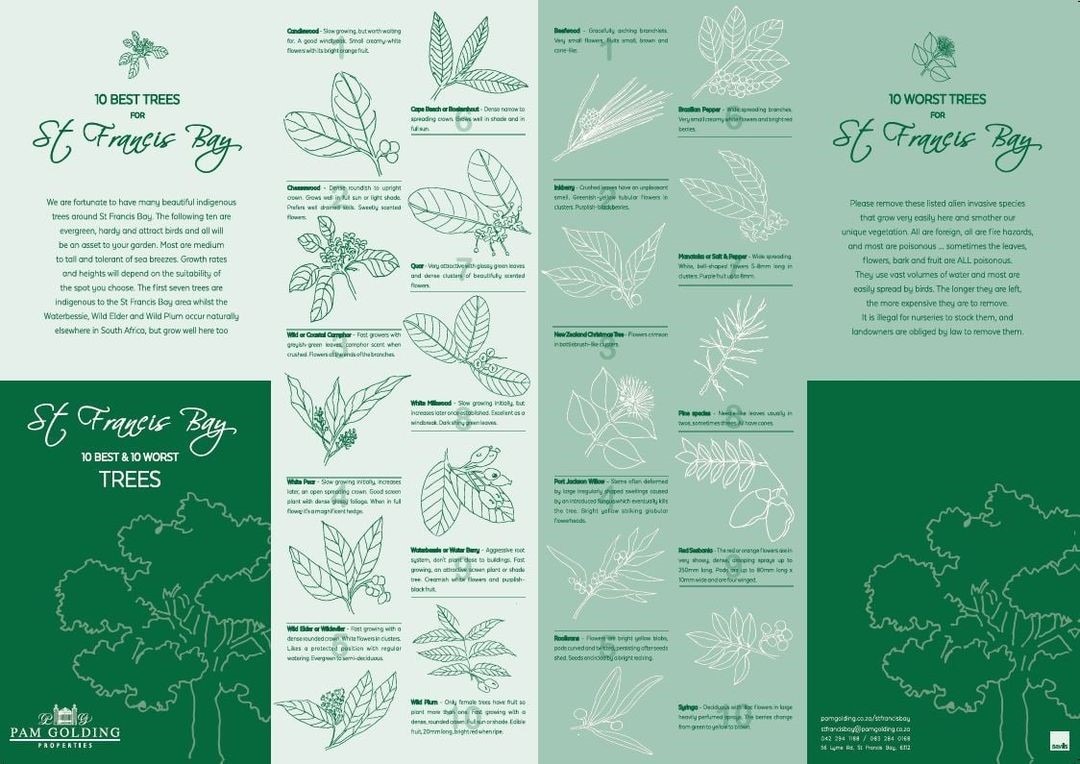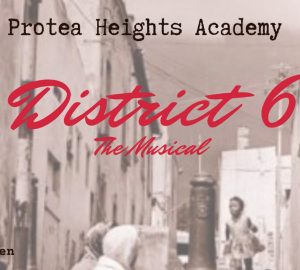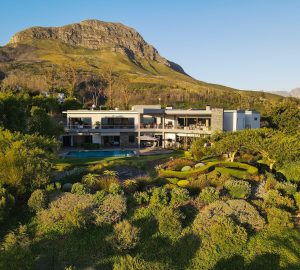Famous local botanist Caryl Logie compiled these lists
Famous local botanist Caryl Logie compiled these lists last year, which we put into a brochure, which is available around the village and at our office. I would especially like all locals to be aware of her 10 worst trees, so I will post photos of them on social media in the coming weeks.
Please remove these listed alien invasive species that grow very easily here and smother our unique vegetation. All are foreign, all are fire hazards, and most are poisonous … sometimes the leaves, flowers, bark and fruit are ALL poisonous. They use vast volumes of water and most are easily spread by birds. The longer they are left, the more expensive they are to remove. It is illegal for nurseries to stock them, and landowners are obliged by law to remove them.
With so many beautiful indigenous trees and shrubs to choose from please don’t plant alien invasive species. We all know about Rooikrans and Port Jackson Willow, but there are many others that grow very easily here and smother our unique vegetation.
We are fortunate to have many beautiful indigenous trees in and around St Francis Bay. The 10 Best Trees are evergreen, hardy and attract birds and all will be an asset to your garden. Most are medium to tall and tolerant of sea breezes. Growth rate and height will depend on the suitability of the spot you choose.
They may not all be obtainable in the horticultural trade, but if you’re wanting to plant a tree why not choose one of these, they all occur here naturally.
Remember to find out about the root systems of the trees you choose. Some have invasive roots so you need to be careful where you plant them.
10 BEST TREES
- Candlewood (Pterocelastrus tricuspidatus). Slow growing, but worth waiting for. A good windbreak. Small creamy-white flowers, but eye catching with its bright orange fruit.
- Cape Beech or Boekenhout (Rapanea melanophloeos). Moderate growth rate with a dense narrow to spreading crown. Grows well in shade and in full sun.
- Cheesewood (Pittosporum viridiflorum). Moderate growth rate with a dense roundish to upright crown. Grows well in full sun or light shade. Prefers well drained soils, and likes a reasonable amount of water. Sweetly scented flowers in dense, terminal clusters.
- Quar (Psydrax obovata). Very attractive with glossy green leaves and dense clusters of beautifully scented flowers.
- Wild or Coastal Camphor (Tarchonanthus littoralis). Fast growth rate with greyish-green leaves that have a delightful camphor scent when crushed. Most attractive with its panicles of flowers at the ends of the branches.
- White Milkwood (Sideroxylon inerme). Slow growing initially but increases later once established. Excellent as a windbreak. Dark shiny green leaves.
- White Pear (Apodytes dimidiata). Slow growing initially, but increases later, with an open spreading crown. A good screen plant in the garden with its dense glossy foliage. Can be grown as a hedge and reacts well to pruning. When in full flower it’s a magnificent hedge.
- Waterbessie or Water Berry (Syzygium cordatum). Aggressive root system, so don’t plant too close to buildings. Fast growing, an attractive screen plant or shade tree. Abundant creamish white flowers and purplish-black edible fruit. Grows well here, but occurs naturally elsewhere in S.A.
- Wild Elder or Wildevlier (Nuxia floribunda). Fast growing with a dense rounded crown. Small white flowers in terminal clusters are eye-catching. Attract insects which in turn attract insect-eating birds. Likes a protected position with regular watering throughout the year. Evergreen to semi-deciduous. Grows well here, but occurs naturally elsewhere in S.A.
- Wild Plum (Harpephyllum caffrum). Female trees only have fruit so plant more than one if possible. Fast growing with a dense, rounded crown. Grows in full sun or shade. Flowers small in branched sprays at the tips of branches. Attractive, edible fruit, 20-25 mm long, bright red when ripe. Grows well here, but occurs naturally elsewhere in S.A.
10 WORST TREES
- Beefwood (Casuarina species). Gracefully arching branchlets. Very small flowers, fruits small, brown and cone-like.
- Brazilian Pepper (Schinus terebinthifolius). Wide spreading branches. Very small creamy white flowers and bright red berries eaten by birds.
- Inkberry (Cestrum species). Crushed leaves have an unpleasant smell. Tubular flowers in clusters are greenish-yellow. Berries are purplish-black and eaten by birds.
- Manatoka or Salt & Pepper (Myoporum species). Wide spreading. White, bell-shaped flowers 5-8mm long in clusters. The purple fruit is up to 8mm and eaten by birds.
- New Zealand Christmas Tree (Metrosideros excelsa). Flowers crimson in bottlebrush-like clusters.
- Pine species (Pinus species). Needle-like leaves usually in twos, sometimes threes. All have cones.
- Port Jackson Willow (Acacia saligna). Stems often deformed by large irregularly shaped swellings caused by an introduced fungus which eventually kills the tree. Bright yellow striking globular flowerheads.
- Red Sesbania (Sesbania punicea). The red or orange flowers are in very showy, dense, drooping sprays up to 250mm long. Pods are up to 80mm long x 10mm wide and are four winged.
- Rooikrans (Acacia cyclops). Flowers are bright yellow blobs, pods curved and twisted, persisting after seeds shed. Seeds encircled by a bright red ring and eaten by birds.
- Syringa (Melia azedarach). Deciduous with lilac flowers in large heavily perfumed sprays. The berries change from green to yellow to brown.
Posted by The Know - Pam Golding Properties






